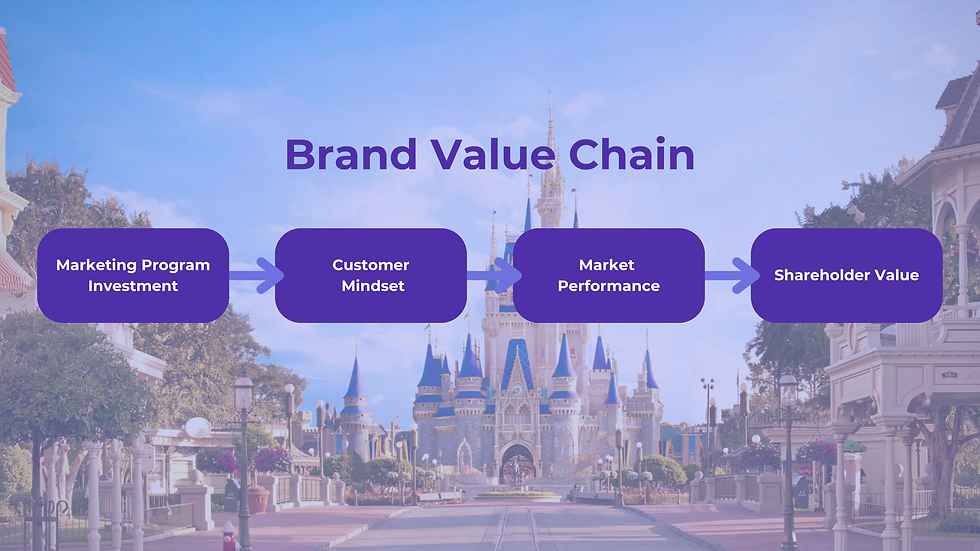Brand Value Chain: A Framework for Measuring Brand Impact
- infomafergonzalez
- Sep 26, 2024
- 4 min read
In previous posts, we discussed the differences between sponsorships and partnerships in marketing and how both of them can be beneficial to your brand, attracting more audiences and creating long-lasting relationships. However, it is crucial for marketers to constantly measure how strong the bond between the brand and consumers is and how they perceive the brand. In other words, understanding the value that the brand generates is essential for marketers who want to master brand equity.
One effective way to gain a better view of the overall equity of the brand is the Brand Value Chain, a method to analyze how brand equity flows from marketing investments to customer perceptions and how financial returns are affected by them. Today, we will learn more about its components and understand how you can apply them to ensure brand success.

What is the Brand Value Chain?
According to Qualtrics, the brand value chain is a “four-step schematic developed by marketing experts” that aims to understand how marketing efforts are helping build the brand and the financial return that results from them.
Since the chain has been around for more than 20 years, it does not specifically consider digital marketing and how social media affects the brand. However, it is still a powerful method to assess the value of a brand in terms of marketing efforts.
The Value Chain not only has stages but also multipliers that affect each stage. Let us take a look at the four stages, according to Marketing91, to deeply understand what marketers look for in each of them, using Disney as our example.
The Four Stages of the Brand Value Chain
1. Marketing Program Investment: It is all about creating a marketing strategy that will generate interest among the right audience. The goal is to create brand awareness and get potential customers to talk about the brand.
Consider Disney, a master of investing in brand-building activities. For example, we often see commercials or even airports wrapped in advertisements for the next Disney movie that is about to premiere. Disney invests heavily in awareness campaigns to keep people talking about them and to reach their desired audience. Check out this commercial from a couple of years ago, tailored to the parents of young children with the goal of making them consider a Disney vacation: “These Are the Moments You’ll Treasure Forever.”

2. Customer Mindset: The next link is about creating a positive perception of the brand. For successful brand equity, potential consumers should not only be aware but also feel positively toward the brand, making them more likely to engage with it in the future. In other words, customer associations with the brand will influence their attitudes toward it.
For example, Disney has mastered the art of building powerful customer associations. When you think of Disney, you think of nostalgia, family, and quality entertainment— these are strong brand associations that set Disney apart from competitors. The loyalty Disney enjoys is the result of years of deliberate marketing investment designed to shape this customer mindset.
3. Market Performance: It is all about achieving commercial success in the marketplace. The goal of this stage is to make sales and grow the market share of the brand. For a brand to be successful, consumers must be actively purchasing the product so it can gain control of the market. In other words, it is also the point where strong consumer loyalty and positive attitudes translate into profitability for the business.
Disney’s theme parks are a perfect example. No matter how expensive spending a full day in a park or buying merchandise might be, Disney fans will continue saving money to come back and purchase Disney items as often as they can. Loyal fans are also most likely to pay for premium experiences such as Lightning Lane passes and VIP tours, as well as limited-edition merchandise.
4. Shareholder Value: When a brand performs well in the marketplace, it ultimately contributes to the company’s financial health, enhancing stock prices, profitability, and overall shareholder value. In other words, brands should have a clear understanding of the market and be able to cover all their production costs through their sales in order to succeed at this stage.

Disney’s brand strength translates directly into impressive financial metrics, consistently delivering value to shareholders through its diversified portfolio of entertainment properties, parks, and products.
For instance, Disney’s acquisition of the Marvel and Star Wars franchises was not just about expanding its content library—it was about extending its brand reach. These strategic investments boosted shareholder value by adding new revenue streams, expanding market share, and reinforcing Disney’s dominance in the entertainment industry.
The Brand Value Chain is essential for marketers to understand how their strategies are being reflected in their target audience and the overall position of the brand in terms of the market. As you can see, it is a way to evaluate the performance of the brand in relation to a specific campaign, from the moment that awareness is created to the value the brand holds in consumers' minds and for shareholders. Incorporate this framework into your future campaigns, and you will notice a significant change in your brand’s results.
If you liked this post, do not forget to subscribe, and continue learning about the various marketing strategies behind one of the most powerful entertainment companies in the world. Have a magical day and see you real soon!

Comments